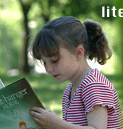Teaching readers to get their knowledge ready: Before-reading
strategies
Many readers need to be taught to get their knowledge ready. One
aspect of this involves teaching readers to plan how they will read.
The types of knowledge readers use to 'get ready' for reading and
types of teaching activities for each are shown in the following
diagram. The self instructions readers learn to use are shown in
italics.
| The purpose for reading? |
Ask readers to describe
- why they think they are reading
- how they will need to use the information gained as a
result of reading.
|
| The likely theme of the text |
"What might the text tell me? How do I know? What will
tell me what it could be about? What does the title tell me?"
Readers can begin by asking the '4W and 1H' questions. |
| Use what you know about the topic |
- "What do I know about this topic already? What do (the
pictures, title) remind me of? What picture do I make when
I hear the title?"
- "What ideas / words might come up in the print? What
might the text tell me? What questions might the story answer?"
|
| How will you go about reading? |
Readers say the actions they might use before they begin to
read. |
| How will I organize the ideas as I read? |
Students note whether text is a narrative, factual text, descriptive
text, argumentative text, etc., and decide how they will act
to organize the ideas. |
| Am I ready to read? |
Readers decide whether they have sufficient knowledge about
the text to begin to read and feel sufficiently confident about
reading. |
Readers can learn to use these strategies when they both read aloud
and read silently.

